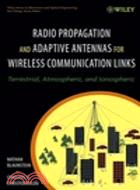| FindBook |
|
有 3 項符合
blaunstein的圖書 |
 |
$ 8800 | Radiophysical and Geomagnetic Effects of Rocket Burn and Launch in the Near-The-Earth Environment
作者:Chernogor,Leonid F./Blaunstein,Nathan 出版社:Taylor & Francis 出版日期:2013-11-13 語言:英文 規格:15.9 x 22.9 x 3.2 cm / 普通級/ 雙色印刷  看圖書介紹 看圖書介紹
|
 |
$ 9075 | Applied Aspects of Optical Communication and LIDAR
作者:Blaunstein 出版社:Auerbach Publications 出版日期:2009-12-01 語言:英文 規格:精裝 / 262頁 / 23.6 x 15.7 x 2 cm / 普通級/ 初版  看圖書介紹 看圖書介紹
|
 |
$ 1406 | RADIO PROPAGATION AND ADAPTIVE ANTENNAS FOR WIRELESS COMMUNICATION LINKS: TERRESTRIAL, ATMOSPHERIC, AND IONOSPHERIC
作者:BLAUNSTEIN 出版社:全華圖書 出版日期:2007-01-05 語言:英文 規格:精裝 / 605頁 / 普級 / 單色印刷 / 初版  看圖書介紹 看圖書介紹
|
|
|
|











